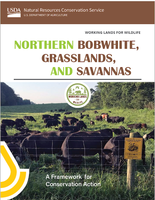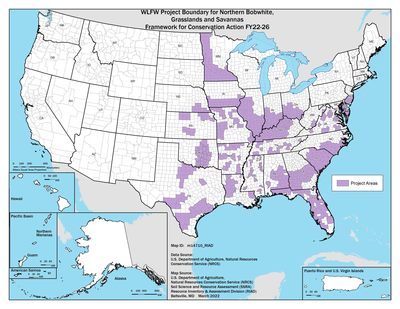Northern Bobwhite Quail, Grasslands & Savannas Partner Website
 Working Lands for Wildlife: Northern Bobwhite, Grasslands and Savannas Framework for Conservation Action is a 2022 publication by NRCS capturing a long-term, large landscape conservation plan to recover central and eastern grasslands for northern bobwhite and other wildlife species. To support the win-win approach of WLFW, this framework also includes anticipated outcomes for risk management and revenue enhancements for agricultural/forestry operations, as well as measured outcomes for greenhouse gas (GHG) mitigation.
Working Lands for Wildlife: Northern Bobwhite, Grasslands and Savannas Framework for Conservation Action is a 2022 publication by NRCS capturing a long-term, large landscape conservation plan to recover central and eastern grasslands for northern bobwhite and other wildlife species. To support the win-win approach of WLFW, this framework also includes anticipated outcomes for risk management and revenue enhancements for agricultural/forestry operations, as well as measured outcomes for greenhouse gas (GHG) mitigation.
NEW MOBILE APP!
A new Mobile App to track Northern Bobwhite on Our Landscapes
The app is a citizen science tool that can be used by the public to contribute to our knowledge of the distribution and abundance of Northern Bobwhite

The central and eastern grassland and savanna regions of the U.S. include the number one crop production states for corn, wheat, sorghum, soybeans, peanuts and cotton. Six of the top ten forest production states are in the East, and the Fescue Belt has the highest concentration of livestock producers and livestock in the country. Southeastern grasslands are the most diverse biologically in the U.S. but also the most imperiled with up to 90% in degraded condition or lost. Major threats include 1) habitat loss and fragmentation, 2) climate change, 3) alterations to natural land disturbance regimes, and 4) invasive species.
To address these threats, NRCS and our partners have brought row crop, livestock, and forest product producers together to develop this Northern Bobwhite, Grasslands, and Savannas Framework for Conservation Action. Building on the WLFW Northern Bobwhite initiative that launched in 2017, the framework will expand WLFW efforts to conservation of whole landscapes and wildlife communities.
In the first 5 years (2022-2026), approximately 7 million acres of conservation practices will achieve a range of specific conservation and economic goals. Twenty-four participating NRCS state offices selected conservation practices they will prioritize. These vary regionally with prescribed fire, restoration of native grasses through prescribed grazing systems, control of brush and invasive plants, and forest stand improvement (thinning to improve tree growth and allow light to reach the understory) among their top practices. Nine of the twenty-four states also plan to add 165,000 acres to the Conservation Stewardship Program, and six states plan to place conservation easements on 3,200 acres. We anticipate that the stewardship and easement programs will see significant growth under this framework in future years.
Precision agriculture can be adapted to inform conservation practice adoption when wildlife objectives are explicitly incorporated into farm and landscape level decision framework. A precision agriculture approach will be utilized to identify where production is a primary landowner objective, and where lands marginally suitable for production could instead be managed to support wildlife. This approach will be used at the farm level, but also at larger landscape scales through funding to Mississippi State University who will identify areas with the most opportunity to apply precision ag approaches – and in those areas WLFW will concentrate technical staff in partnership with Pheasants Forever/Quail Forever to help producers identify conservation opportunities and make economically sound decisions.
Peer reviewed literature has established that the northern bobwhite is a good indicator for the status of other grassland wildlife, especially birds. Northern bobwhite declined by over 80% in the last three decades, a decline that mirrors our loss of native grasslands and savannas. Landscape context is critical to bobwhite and other wildlife – it’s not enough to have an island of great habitat. The National Bobwhite Conservation Initiative identified 1500-acre habitat blocks as focal landscapes for bobwhite recovery. By strategically increasing connectivity of these blocks, we will create landscape corridors to meet seasonal habitat requirements. In these networked landscapes, partner staff will monitor northern bobwhite and other wildlife species to determine their response to our efforts over time.
WLFW is anticipating the following outcomes will result from conservation actions within this framework:
1) Wildlife Benefits
Anticipated outcomes include, of course, habitat conservation outcomes to address the life cycle needs of northern bobwhite and other wildlife. Monitoring of conservation outcomes will be accomplished by Quail Forever partner staff in cooperation with the National Bobwhite Technical Committee. NRCS has funded an agreement with the University of Georgia to collate the states’ data and develop landscape and population models as outcomes assessments.
2) Economic Benefits, both Risk Management and Revenue Enhancement
WLFW has determined that we can assist producers in managing financial risks like those resulting from droughts or wildfires, for example, through implementation of some of the same practices that benefit wildlife. Furthermore, many installed practices will also result in revenue enhancements to agricultural and forestry operations as measured outcomes. Revenue enhancements include greater access to carbon markets, increases in huntable or viewable wildlife, and improved herd or commodity (e.g., timber, crop) health. Economic outcomes are consistent with the win-win approach of WLFW.
3) Climate Change Mitigation.
NRCS is supporting climate-smart agriculture and forestry and will apply 35 practices that the agency has determined measurably reduce greenhouse gas (GHG) emissions. Agency and partner staff will help producers implement voluntary conservation practices that sequester carbon, reduce greenhouse gas emissions, and thereby mitigate the impacts of climate change on working lands. Under this framework, WLFW will report outputs for these 35 practices, then NRCS will calculate and share GHG mitigation outcomes. NRCS is also working to identify a suite of Farm Bill conservation practices for which we can measure climate adaptation benefits that address threats and increase landscape resilience. That work will continue and be incorporated into the conservation actions under this framework over time.
Strategically placed conservation practices are the lowest risk option to benefit landscape health and biodiversity regardless of future conditions of climate change. Acting now will magnify conservation and economic benefits for our future. The Society for Ecological Restoration has stated “Restoration is fundamentally a hopeful activity that can meaningfully improve the condition of our world.” This framework represents hope for grassland and savanna landscapes, for northern bobwhite and biodiversity, and for producers.
Content Link: NRCS Northern Bobwhite Quail Website























